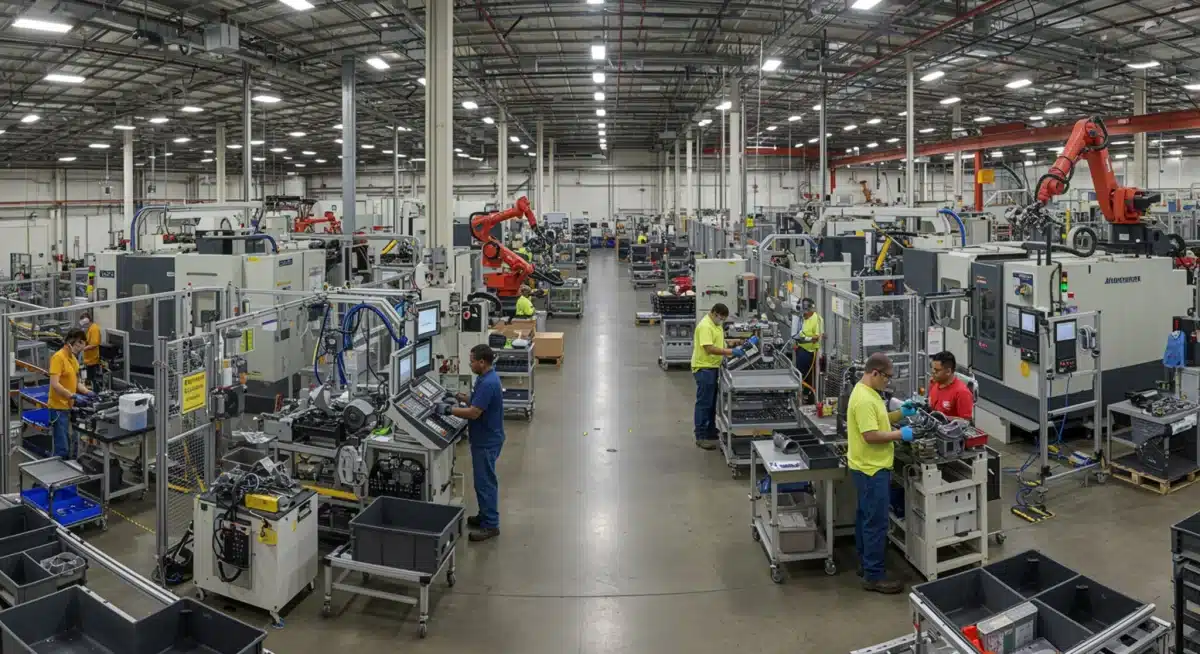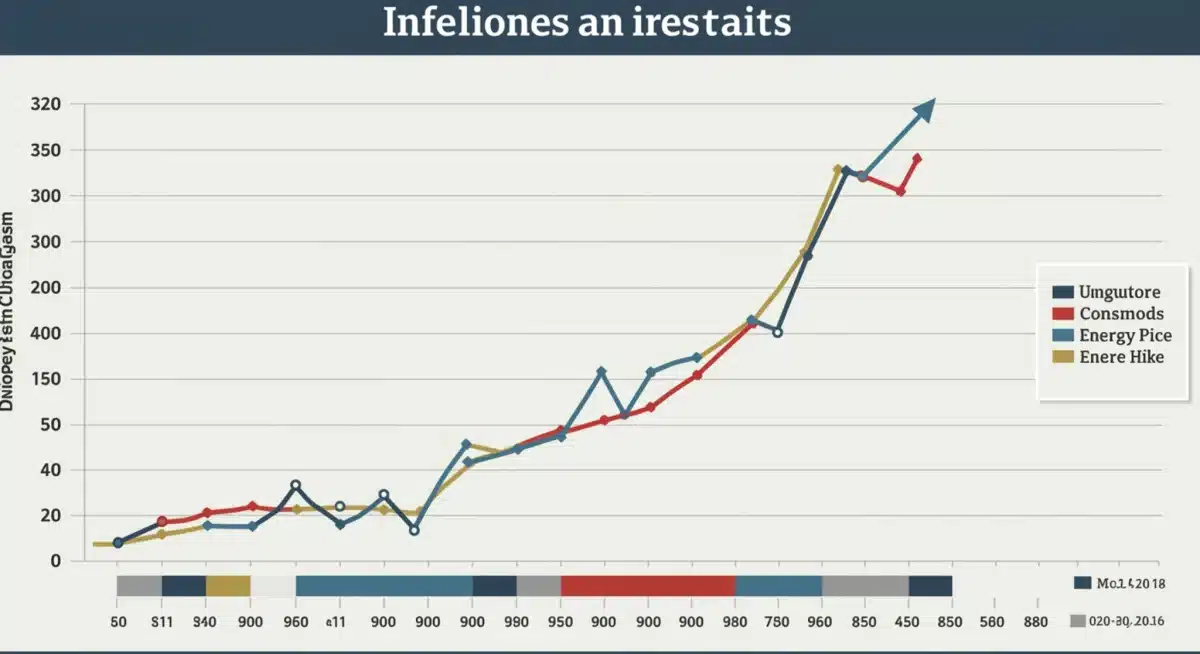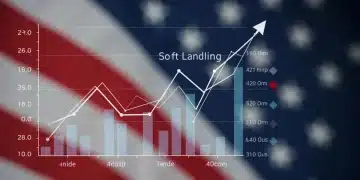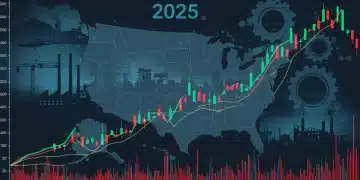Global Supply Chain Disruptions: Impact on US Economy This Year

Global supply chain disruptions are significantly impacting the US economy this year, manifesting as inflationary pressures, altered consumer spending habits, and strategic shifts in business operations to build resilience and mitigate future risks.
Have you ever stopped to consider how the journey of a product from its raw material source to your shopping cart affects your daily life and the broader economic landscape? This year, understanding the profound global supply chain impact on the US economy has become more critical than ever. From rising prices at the grocery store to delays in receiving ordered goods, these disruptions are not just abstract economic concepts but tangible realities shaping our present and future.
The evolving landscape of global supply chain disruptions
The global supply chain, a complex network of interconnected processes, has faced unprecedented challenges in recent years. What started as localized incidents has cascaded into a worldwide phenomenon, fundamentally altering how goods are produced, transported, and consumed. This year, the US economy continues to grapple with the lingering effects of these disruptions, alongside new emerging pressures.
Initially, pandemic-induced lockdowns and shifts in consumer demand created bottlenecks. Factories shut down, ports became congested, and labor shortages exacerbated existing vulnerabilities. While some of these initial shocks have begun to normalize, new geopolitical tensions, climate-related events, and persistent labor market imbalances ensure that the supply chain remains a dynamic and often unpredictable force.
Geopolitical tensions and trade policy shifts
The geopolitical landscape plays a significant role in shaping global supply chains. Trade disputes, sanctions, and regional conflicts can abruptly alter sourcing strategies and transportation routes, leading to increased costs and reduced availability of essential goods.
- Trade Barriers: Imposition of tariffs and non-tariff barriers can make imports more expensive, prompting companies to seek alternative, often less efficient, suppliers.
- Regional Conflicts: Disruptions in key shipping lanes or resource-rich regions can halt the flow of crucial components and raw materials, impacting global production schedules.
- National Security Concerns: Governments increasingly prioritize domestic production for critical goods, leading to reshoring efforts that, while beneficial long-term, create short-term cost increases and logistical challenges.
Climate change and natural disasters
The increasing frequency and intensity of extreme weather events pose significant threats to the physical infrastructure of supply chains. From hurricanes disrupting port operations to droughts affecting agricultural output, climate change is a formidable and growing factor.
These events not only cause immediate physical damage but also create ripple effects, delaying shipments, increasing insurance costs, and forcing businesses to build in greater redundancy, which can translate to higher consumer prices. The unpredictability of these events makes long-term planning incredibly complex for logistics and manufacturing sectors.
Inflationary pressures and consumer impact
One of the most direct and noticeable consequences of global supply chain disruptions on the US economy this year has been the persistent inflationary pressure. When the cost of producing and transporting goods rises, these costs are often passed on to the consumer, leading to higher prices for a wide range of products and services.
This phenomenon, sometimes referred to as ‘supply-side inflation,’ differs from demand-driven inflation and requires different policy responses. Consumers feel the pinch directly in their wallets, altering spending habits and potentially slowing economic growth. The availability of goods also plays a crucial role; scarcity can drive prices up even further, creating a challenging environment for households and businesses alike.
Rising costs of raw materials and components
The fundamental building blocks of virtually all manufactured goods — raw materials and components — have seen significant price volatility. Shortages in critical inputs like semiconductors, rare earth minerals, and certain agricultural commodities have driven up their costs, which then propagate through the entire production process.
- Semiconductor Shortages: The scarcity of computer chips has impacted industries from automotive to consumer electronics, delaying production and increasing the final price of products.
- Energy Price Volatility: Fluctuations in oil and gas prices directly affect transportation costs for both raw materials and finished goods, contributing to overall inflation.
- Agricultural Commodity Prices: Weather events and geopolitical factors can lead to spikes in food prices, impacting household budgets significantly.
Increased shipping and logistics expenses
The movement of goods across oceans and continents has become considerably more expensive. Container shipping rates, fuel costs, and port congestion surcharges have all contributed to a substantial increase in logistics expenses. These costs are ultimately factored into the retail price of imported goods.
Labor shortages in the trucking industry and at ports further exacerbate these issues, creating delays and inefficiencies. Businesses are often forced to choose between absorbing these higher costs, thereby reducing their profit margins, or passing them on to consumers, risking reduced demand. This delicate balance is a constant challenge for companies operating within the disrupted global framework.
Reshaping industries and business strategies
In response to the ongoing global supply chain impact, US industries are not simply reacting but actively reshaping their strategies. Businesses are recognizing that the ‘just-in-time’ inventory models, once lauded for efficiency, are vulnerable to disruptions. A new emphasis on resilience, diversification, and localization is emerging, fundamentally altering how companies approach their supply chain management.
This strategic shift involves significant investment in technology, infrastructure, and human capital, with the aim of building more robust and adaptable supply networks. The goal is not just to survive the current disruptions but to thrive in a perpetually uncertain global economic environment, ensuring continuity and stability for future operations.

Nearshoring and reshoring initiatives
Many US companies are exploring nearshoring (moving production closer to home, often to neighboring countries) or reshoring (bringing production back to the United States) as a means to reduce reliance on distant and potentially unstable supply sources. While these moves can increase initial production costs, they offer benefits such as reduced lead times, lower transportation expenses, and greater control over quality and labor practices.
Government incentives and a renewed focus on domestic manufacturing are also fueling these trends. The long-term implications include job creation within the US, enhanced national security regarding critical goods, and a more localized economic footprint. However, the transition is complex, requiring significant investment in new facilities and workforce training.
Technological adoption and digital transformation
Technology is proving to be a critical enabler for navigating supply chain complexities. Companies are investing in advanced analytics, artificial intelligence (AI), and blockchain to gain greater visibility and control over their supply networks. Digital twins, predictive modeling, and real-time tracking systems allow for proactive identification of potential disruptions and more agile responses.
- AI-driven forecasting: Utilizing AI to predict demand fluctuations and potential supply bottlenecks, allowing for better inventory management.
- Blockchain for transparency: Implementing blockchain technology to create immutable records of product journeys, enhancing traceability and reducing fraud.
- Automation in logistics: Deploying robotics and automation in warehouses and ports to mitigate labor shortages and improve efficiency.
Government responses and policy implications
The US government has recognized the critical nature of global supply chain disruptions and has initiated various policy responses aimed at mitigating their impact and building long-term resilience. These actions range from strategic investments to diplomatic efforts, all with the overarching goal of stabilizing the economy and protecting national interests.
Policy implications extend beyond immediate crisis management, focusing on creating a more robust economic framework that can withstand future shocks. This includes fostering domestic production capabilities, strengthening international partnerships, and investing in critical infrastructure to streamline the flow of goods.
Strategic investments and infrastructure upgrades
Significant government funding is being directed towards improving domestic infrastructure, including ports, roads, and railways, to enhance the efficiency of goods movement. Furthermore, strategic investments are being made in key sectors, such as semiconductor manufacturing, to reduce reliance on foreign suppliers for critical components.
These investments are designed to create a more resilient national supply chain ecosystem, capable of supporting both economic growth and national security. The long-term vision involves a modernized infrastructure that can handle increased trade volumes and respond effectively to unexpected disruptions, thereby minimizing economic fallout.
International cooperation and trade agreements
The US government is actively engaging in international diplomacy and negotiating new trade agreements to diversify supply sources and strengthen global partnerships. Collaborative efforts with allies aim to create more resilient and reliable supply networks, reducing collective vulnerability to disruptions.
These initiatives seek to establish clear rules of engagement, improve transparency, and promote fair trade practices across the global economic landscape. By fostering stronger international ties, the US aims to secure access to essential goods and materials, while also promoting economic stability worldwide.
The workforce and labor market dynamics
The intricate relationship between global supply chain disruptions and the US labor market cannot be overstated. From truck drivers to factory workers, the human element is central to the movement and production of goods. Disruptions have exposed vulnerabilities and created new demands within the workforce, leading to significant shifts in labor market dynamics.
Labor shortages in key sectors, particularly transportation and logistics, have exacerbated supply chain issues, contributing to delays and increased costs. In response, businesses and policymakers are exploring solutions ranging from increased automation to enhanced training programs, all aimed at building a more resilient and adaptable workforce.
Labor shortages in transportation and logistics
The trucking industry, port operations, and warehousing sectors have faced persistent labor shortages, creating bottlenecks in the movement of goods. An aging workforce, challenging working conditions, and a lack of new entrants have contributed to this deficit, leading to delays and increased freight costs.
- Truck Driver Shortage: A long-standing issue, exacerbated by the pandemic, leading to higher wages for drivers and increased shipping costs for businesses.
- Port Worker Availability: While some congestion has eased, the availability of skilled labor at ports remains a factor in efficient cargo handling.
- Warehouse and Distribution Center Staffing: The surge in e-commerce has increased demand for warehouse workers, leading to competition for labor and higher wages.
Skills gap and training initiatives
The evolving nature of supply chain management, with its increasing reliance on technology and data analytics, has highlighted a skills gap within the workforce. There is a growing demand for professionals with expertise in areas such as logistics technology, data science, and predictive analytics.
To address this, educational institutions and industry partners are developing new training programs and apprenticeships. These initiatives aim to equip the current and future workforce with the necessary skills to navigate complex supply chains, ensuring that the US economy has the human capital required for resilience and growth.
Consumer behavior and market adaptations
The ripple effects of global supply chain disruptions extend directly to consumer behavior, forcing individuals and households to adapt to new realities. From altered shopping habits to a greater emphasis on local sourcing, the market is undergoing significant transformations. These adaptations, in turn, influence business strategies and the overall economic landscape.
Consumers are becoming more aware of the fragility of global supply chains and are increasingly prioritizing factors such as product availability, ethical sourcing, and sustainability. This shift in consumer mindset is driving businesses to innovate and respond with more transparent and resilient practices.
Shifting purchasing patterns and brand loyalty
When favorite products are unavailable or prices soar, consumers often adapt by switching brands, seeking alternatives, or delaying purchases. This can lead to a decrease in brand loyalty and an increase in price sensitivity, forcing companies to re-evaluate their marketing and pricing strategies.
The rise of private labels and generic brands also reflects consumers’ search for more affordable and readily available options. Businesses are responding by diversifying their product offerings, improving inventory management, and communicating transparently about potential delays or shortages to maintain customer trust.
Emphasis on local sourcing and sustainable practices
A growing number of consumers are prioritizing locally sourced products, driven by a desire to support local economies, reduce environmental impact, and mitigate the risks associated with long global supply chains. This trend is encouraging businesses to invest in regional suppliers and production facilities.

Furthermore, sustainability has become a key factor in consumer choices. Shoppers are increasingly looking for products manufactured and transported using environmentally friendly practices. This demand is pushing companies to adopt greener supply chain strategies, from reducing carbon emissions in logistics to sourcing materials responsibly, aligning with both consumer values and long-term business resilience.
Future outlook and long-term resilience
Looking ahead, the US economy is expected to continue adapting to the persistent challenges posed by global supply chain disruptions. The lessons learned from recent years are driving a fundamental shift towards building long-term resilience, moving beyond reactive measures to proactive strategies that anticipate and mitigate future shocks. This involves a multi-faceted approach encompassing technological innovation, strategic partnerships, and robust policy frameworks.
The goal is to create a supply chain ecosystem that is not only efficient but also agile, transparent, and secure, capable of supporting sustained economic growth and stability in an increasingly complex world. This transformation will require ongoing collaboration between government, industry, and academia to foster innovation and develop best practices.
Investment in advanced manufacturing and automation
To bolster resilience, there will be continued and perhaps accelerated investment in advanced manufacturing technologies, including automation, robotics, and additive manufacturing (3D printing). These technologies can shorten production cycles, reduce labor dependency, and enable more flexible and localized production capabilities.
By bringing production closer to home and adopting highly automated processes, businesses can reduce their exposure to international disruptions and increase their capacity to respond quickly to changes in demand or supply conditions. This strategic shift is crucial for enhancing the US manufacturing base and ensuring a stable supply of critical goods.
Data analytics and AI for predictive capabilities
The future of supply chain management will heavily rely on sophisticated data analytics and artificial intelligence to enhance predictive capabilities. By leveraging vast amounts of data—from weather patterns and geopolitical shifts to consumer demand signals—AI algorithms can identify potential disruptions before they occur.
This proactive approach allows companies to reroute shipments, adjust production schedules, and secure alternative supplies much more effectively than traditional reactive methods. The ability to foresee and mitigate risks will be a cornerstone of resilient supply chains, minimizing economic impact and ensuring operational continuity.
| Key Impact Area | Brief Description |
|---|---|
| Inflationary Pressures | Increased costs of raw materials, shipping, and labor lead to higher consumer prices across various sectors. |
| Business Strategy Shifts | Companies are adopting nearshoring, reshoring, and investing in technology for greater supply chain resilience. |
| Labor Market Dynamics | Shortages in logistics and transportation sectors, alongside a growing skills gap, necessitate new training initiatives. |
| Consumer Behavior Changes | Consumers are shifting purchasing patterns, emphasizing local sourcing and sustainable practices due to availability and price. |
Frequently asked questions about supply chain disruptions
Disruptions increase the costs of raw materials, manufacturing, and transportation. These elevated costs are typically passed on to consumers through higher prices for goods and services, leading to widespread inflationary pressures across the economy.
Reshoring involves bringing manufacturing back to the company’s home country, like the US. Nearshoring means moving production to a closer, often neighboring country, reducing geographical distance and logistical complexities compared to distant international sourcing.
Technology like AI, data analytics, and blockchain enhances visibility and predictability. AI can forecast demand and identify bottlenecks, while blockchain improves transparency and traceability, enabling quicker responses to disruptions and more efficient operations.
Government policies include strategic investments in infrastructure and critical industries, fostering domestic production, and engaging in international cooperation to diversify supply sources and strengthen trade agreements. These efforts aim to build long-term economic resilience.
Consumers are adapting by shifting purchasing patterns, becoming more price-sensitive, and increasingly prioritizing local sourcing and sustainable products. This leads to reduced brand loyalty and a greater demand for transparent and resilient business practices.
Conclusion
The ongoing global Supply Chain disruptions highlight not just short-term inefficiencies but a fundamental transformation in how the U.S. economy functions.
What began as bottlenecks during global crises has now revealed systemic weaknesses that require innovation, strategic policy, and corporate adaptability to overcome.
Inflationary pressures, shifting consumer behaviors, and the push toward nearshoring are all deeply tied to how effectively the Supply Chain evolves in response to these challenges.
Building resilience in the Supply Chain requires more than quick fixes; it demands long-term strategies that integrate digital technologies, automation, and data-driven insights.
Companies are increasingly recognizing that a responsive and transparent Supply Chain is not merely a cost factor but a critical driver of competitiveness and stability.
At the same time, government interventions and international cooperation remain pivotal in mitigating risks and ensuring steady flows of goods, labor, and capital.
For organizations seeking actionable insights into how disruptions shape decisions, this analysis on Supply Chain effects provides valuable guidance for leaders and policymakers.
Ultimately, the future of Supply Chain management will determine whether the U.S. economy can achieve lasting stability and growth.
By embracing resilience, sustainability, and innovation, the nation can transform current disruptions into an opportunity to build stronger, smarter, and more reliable global networks.
Liked the article?





